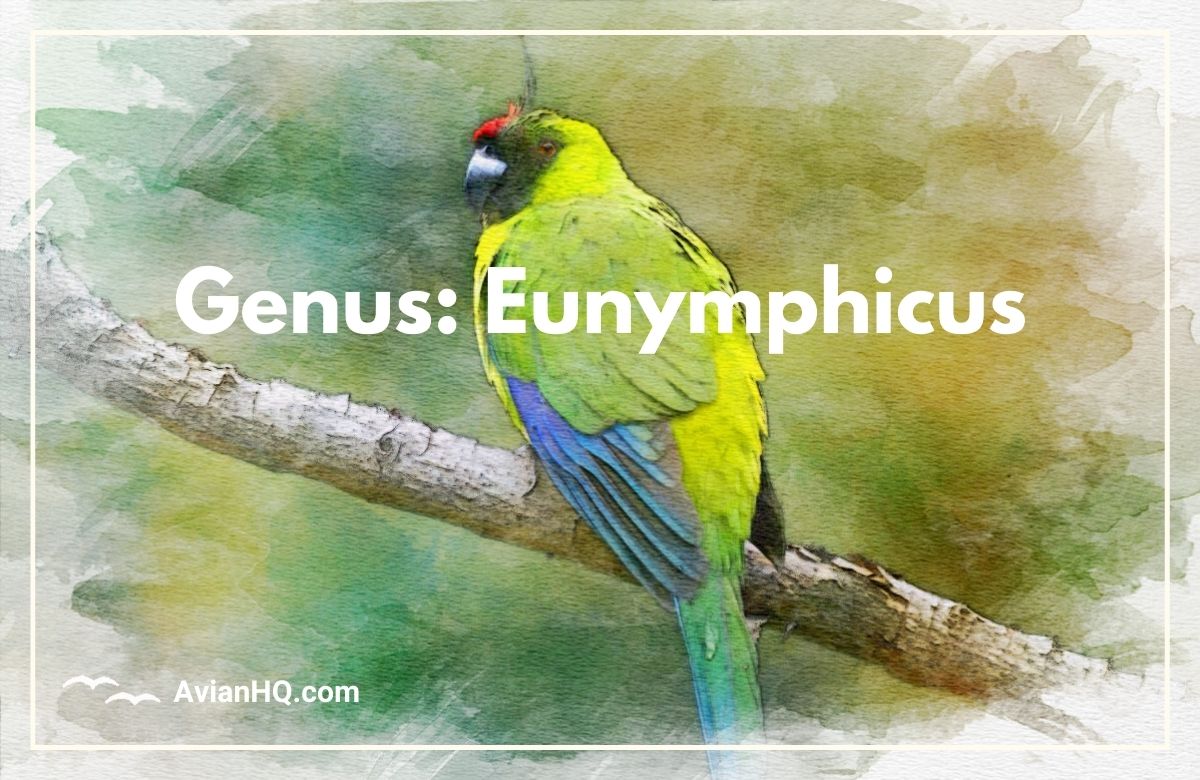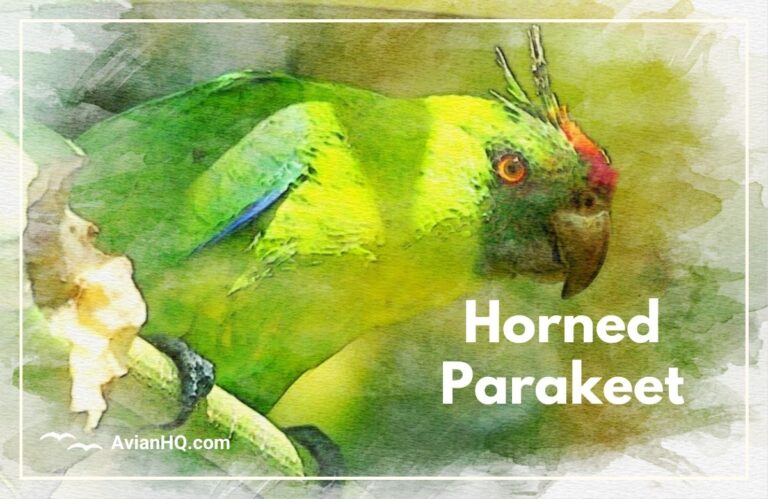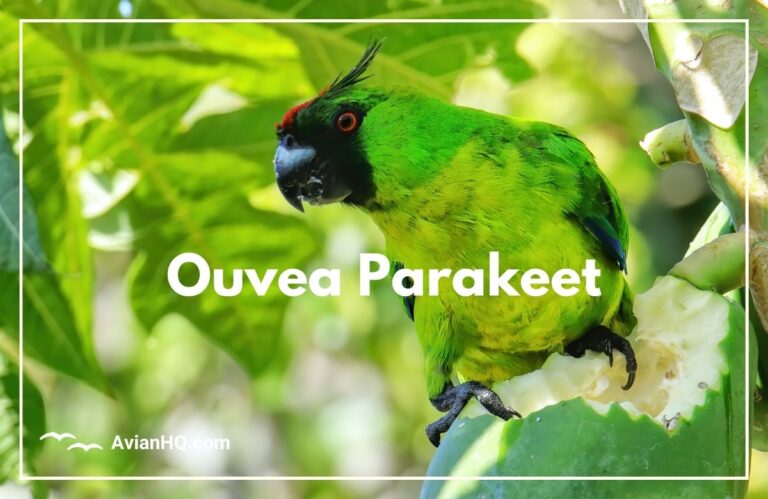Genus: Eunymphicus
With their brightly colored plumage and lively personalities, Eunymphicus parakeets are truly captivating birds. As you read on, you will discover what makes this genus of parrots found across islands of New Caledonia so special.
The genus contains only two extant species:
- The Horned Parakeet, named for the pair of feathers on its head that resemble horns
- The Ouvea Parakeet, a critically endangered green parrot numbering fewer than 300 in the wild
Both species play important roles in their island ecosystems. However, habitat destruction and trapping for the pet trade have landed them endangered classifications.
Conservation efforts currently underway provide hope. But more action is still needed to ensure the survival of these remarkable island birds into the future.
Through this article, you will gain deeper insight into Eunymphicus parakeets:
“These parrots showcase the unique biodiversity of New Caledonia. With vibrant green feathers and horns for some extra pizzazz, they have charisma in spades!”
Read on to explore what makes them stand out in terms of behavior, ecology, cultural significance, and conservation status. Gaining this knowledge can motivate you to support the preservation of the Eunymphicus genus.
Species Spotlights
The genus Eunymphicus contains two unusual parrot species found only in New Caledonia and its nearby islands. Let’s spotlight what makes each one distinctive:
Horned Parakeet (Eunymphicus cornutus)
This bright parrot measuring 13 inches (33 cm) draws the eye with its vibrant green feathers and, of course, the pair of feather “horns” sprouting from its head. These horns lend the Horned Parakeet its name and contribute to its unmistakable appearance.
The species inhabits forests across the main island of New Caledonia. Its diet consists mainly of fruit, seeds, nectar, and some insect larvae.
The Horned Parakeet is classified as endangered by the IUCN Red List with only 5,000-10,000 mature individuals remaining. Habitat loss and trapping for the pet bird trade have caused its numbers to decline drastically.
Ouvea Parakeet (Eunymphicus uvaeensis)
Slightly smaller than its horned cousin at 11 inches (28 cm) long, the Ouvea Parakeet sports bright green feathers over its entire body, with some lighter yellow underside plumage. It breeds only on Ouvéa Island, part of the Loyalty Island chain.
With fewer than 300 individuals remaining, the Ouvea Parakeet is critically endangered. Here too trapping and habitat destruction have pushed the species to the brink.
These two Eunymphicus parakeets have unique traits and behaviors we’ll explore more below. Their severely threatened status also makes understanding conservation efforts to save them crucial.
Behavior and Intelligence
Eunymphicus parakeets display a variety of behaviors and notable intelligence like many other parrots. Understanding how they live day-to-day and navigate their forest environments gives us greater appreciation for them.
General Behavior Patterns
Both Horned and Ouvea Parakeets are highly social, traveling together in pairs or small flocks numbering up to 30 individuals. They take advantage of their sociability to forage for food while keeping vigilant for predators.
These parakeets nest in naturally formed tree hollows, with females laying three to four eggs per clutch. The parents work together to dutifully incubate the eggs and raise the chicks.
Fruit forms a major part of the diet of Eunymphicus parakeets, including figs and various berries. They supplement with tree seeds, flower nectar, buds, herbs, and some insect larvae. Their strong beaks allow them to crack hard nuts and seeds.
Intelligence and Cognition
Like many parrot species, Eunymphicus parakeets show impressive intelligence and cognitive abilities. Their big brains relative to body size facilitate complex behaviors.
They can solve problems, use basic tools to retrieve food items, and mimic human speech sounds. Their communications with flock members also demonstrate social intelligence.
In the wild, they choose nesting sites offering optimal protection, an indicator of good judgement and environmental awareness. Their curious, playful nature serves them well when adapting to different situations.
We still have more to uncover about the full mental capabilities of these island parakeets. But current evidence clearly shows their advanced intelligence compared to many other bird groups.
Cultural Significance
The parrots of the genus Eunymphicus hold meaning for the native peoples and broader culture of New Caledonia. Let’s explore their significance from folklore to national symbolism.
Importance in Native Folklore and Legends
According to local indigenous oral tradition, the Ouvea Parakeet brought seeds to the Loyalty Islands at the beginning of time. This folk tale highlights the key role the parakeet played in spreading plant life across the islands.
Meanwhile, the horns of the Horned Parakeet spawned creative mythical explanations. Legends suggest they resulted from the bird getting too close to the sun and having its head feathers singed.
These stories emphasize the cultural relevance of Eunymphicus parakeets in the history and lore of New Caledonian tribes over generations.
Significance as National Symbol
Such is the affinity and pride New Caledonians have for their rare endemic parrots that the Horned Parakeet appears on the island chain’s coat of arms. Its image conveys the uniqueness of New Caledonia’s fauna.
Eunymphicus parakeets also feature on local postage stamps, currency, and in architecture and monuments. They epitomize native wildlife as a symbol of national identity.
Role in Ecosystem Health
Beyond the cultural sphere, both Eunymphicus species contribute vitally to forest health through seed dispersal and pollination as they feed. Their extinction would likely destabilize delicate island ecosystems further.
Losing these birds means losing an irreplaceable part of New Caledonia’s natural heritage.
Threats and Conservation
Unfortunately, both species of Eunymphicus parakeets face severe threats driving their worrying declines. However, conservation efforts are also underway aiming to ensure their future viability.
Habitat Loss
Extensive habitat destruction through logging, mining, and conversion to agricultural land has ravaged the New Caledonian forests these parrots depend on. With nesting and feeding resources vanishing, their survival is jeopardized.
For the Ouvea Parakeet, introduced predators like cats and rats added further pressure. Predation of eggs and chicks by these non-native animals continues to hamper breeding success.
Trapping for Pet Trade
The international cage bird trade has illegally captured Eunymphicus parakeets for decades to supply demand for them as exotic pets. Despite the practice being banned since 1981, trapping still persists as a key threat.
Exact trade volumes are unknown, but trappers annually take up to 1,500 birds from New Caledonian forests. For species as endangered as these parakeets, such losses are catastrophic.
Conservation Breeding Efforts
To supplement and bolster wild populations, successful captive breeding programs for Eunymphicus species operate in New Caledonian conservation centers. The programs carefully manage genetically diverse pairs.
Bred parakeets get released into protected habitats to increase numbers at secure sites. Such initiatives are vital to overcoming threats from habitat loss and trapping over the long term.
Habitat Restoration
Replanting native vegetation, controlling invasive species, installing nest boxes, and designating protected reserves also aids conservation work to revive parakeet numbers.
Ouvea Island has undergone extensive ecological restoration. These efforts resulted in the 2019 translocation of 48 captive-bred Ouvea Parakeets to the island, with more to follow.
Legal Protections
At the regulatory level, New Caledonia has implemented bans on capturing, possessing or exporting Eunymphicus parakeets. Heftier fines now apply to breaches of wildlife trade laws too.
Bolstered legal protections demonstrate increased political will to punish threats and ensure government-backed conservation.
The multifaceted conservation strategies in place offer genuine hope. But ongoing habitat damage and trapping make the future survival of these parakeets far from assured.
Conclusion
As we have seen, the parakeets belonging to the genus Eunymphicus are truly exceptional birds. Found only in New Caledonia and its Loyalty Islands, they play indispensable roles in island ecology that we cannot afford to lose.
With their vibrant green plumage, horns in the case of the Horned Parakeet, incredible intelligence, and cultural symbolism, they showcase the rich biodiversity of this unique South Pacific archipelago.
However, the sobering reality is that rampant habitat destruction and trapping pressure have made them endangered species barely clinging to survival.
While promising conservation initiatives are underway, the need for environmental education and stronger wildlife policies remains. Securing the long-term futures of these parakeets ultimately relies on human responsibility.
Every one of us can contribute by supporting nonprofit conservation groups, respecting ecotourism guidelines when visiting New Caledonia, and speaking out against the illegal cage bird trade.
It is not too late to give these magnificent parrots increased protections and forest habitats where their captivating colors and behaviors will brighten the landscape for generations to come. But we must act quickly before vanishing New Caledonian endemic jewels like the Eunymphicus parakeets are lost forever.



